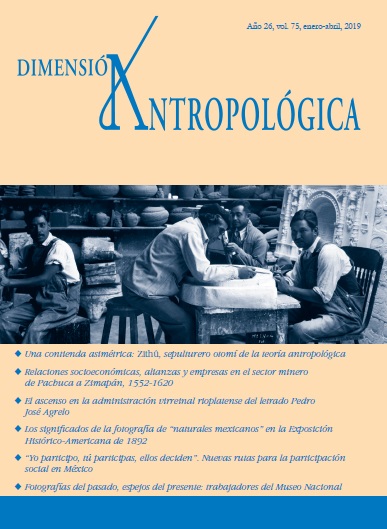Publicado 2019-11-12
Palabras clave
- Otomí,
- Zithû (Diablo),
- tercio analítico intersubjetivo,
- teoría antropológica,
- heteroglosia
Cómo citar
Resumen
Se plantea aquí un problema recurrente en la investigación de campo entre los pueblos de tradición otomí: las dificultades del observador para afirmar una autoridad monológica, para formular propuestas aceptables ante el gremio académico, puesto que la doxa nativa considera que todo el espacio interaccional se halla bajo la custodia del Diablo (Zithû). La teoría antropológica es una construcción que procede por eliminación para poder elaborar un modelo, el cual no puede tolerar excepciones... si no se desbarata. El Diablo otomí deconstruye cualquier “buena” teoría mediante su nzahki, fuerza exterior e interior al hombre que representa un componente lábil y activo, el cual parasita los pensamientos y los actos. No se puede concebir, en términos otomíes, una función cognoscitiva estable, ajena a los actos de Zithû, quien se burla de las clasificaciones y constantemente genera juicios de verdad contradictorios, que representan un desafío casi insuperable para la interpretación del investigador.
Descargas
Referencias
- Anselm, Proslogion — Discourse on the Existence of God, Pickerington, Beloved Publishing, 2014.
- Bahr, Donald M., Juan Gregorio, David I. López, y Albert Álvarez, Piman Shamanism and Staying Sickness (Ká:cim Múmkidag), Tucson, The University of Arizona Press, 1974.
- Bingham, Charles, Authority is Relational: Rethinking Educational Empowerment, Nueva York, State University of New York Press, 2009.
- Clifford, James, “On Ethnographic Authority”, Representations, núm. 2, 1983, pp. 118-146.
- Fierro Alonso, Ulises, “Órdenes y desórdenes del diablo otomí”, en Catharine Good Eshelman y Marina Alonso Bolaños (coords.), Creando mundos, entrelazando realidades, cosmovisiones y mitologías en el México indígena, México, INAH, 2014, pp. 97-110.
- Freud, Sigmund, “Das Unheimliche”, en Gesammelte Werke, vol. XII, Londres, Imago Publishing, 1947, pp. 229-267.
- ____________, “Charakter und Analerotik”, en Werke aus den Jahren 1906-1909, Fráncfort del Meno, Fischer, 1999, pp. 203-209.
- Galinier, Jacques, La moitié du monde - Le corps et le cosmos dans le rituel des Indiens otomi, París, Presses Universitaires de France, 1997.
- ____________, “Un pensamiento de la noche. El dualismo crítico de los otomíes contemporáneos”, en Aurore Monod Becquelin y Jacques Galinier (coords.), Las cosas de la noche. Una mirada diferente, México, CEMCA, 2016, pp. 39-46.
- Güereca Durán, Raquel Eréndira, Un dios y un rey para los indios. La rebelión indígena de Tutotepec, 1769, México, UNAM / Bonilla Artigas Editores, 2014.
- Hernández Cruz, Luis, Moisés, Victoria Torquemada, y Donald Sinclair Crawford, Diccionario del Hñähñu (Otomí) del valle del Mezquital, Estado de Hidalgo, 2a ed. [electrónica], México, Instituto Lingüístico de Verano, 2010, p. 401, recuperado de:
<https://www.sil.org/system/files/reapdata/92/05/99/92059927774128627662217754267521144782/ote_diccionario_ed2.pdf>. - Lastra, Yolanda, El otomí de Ixtenco, México, UNAM, 1997.
- López Austin, Alfredo, y Luis Millones (eds.), Cuernos y colas. Reflexiones en torno al Demonio en los Andes y en Mesoamérica, Lima, Fondo Editorial de la Asamblea Nacional de Rectores, 2013.
- Nasio, Juan Daniel, Enseignement de 7 concepts cruciaux de la psychanalyse, París, Rivages, 1988.
- Ogden, Thomas, “Le tiers analytique - Les implications pour la théorie et la technique psychanalytique”, Revue Française de Psychanalyse, vol. 69, núm. 3, 2005, pp. 733-747.
- Pérez, Francisco, Catecismo de la Doctrina Cristiana en lengua otomí, México, Imprenta de la Testamentaria de Valdés, 1834.
- Pitrou, Perig, Le chemin et le champ — Parcours rituel et sacrifice chez les Mixe de Oaxaca (Mexique), Nanterre, Société d’Ethnologie, 2016.
- Sperber, Dan, “L’Interprétation en anthropologie”, L’Homme, vol. 21, núm. 1, 1981, pp. 69-92.

